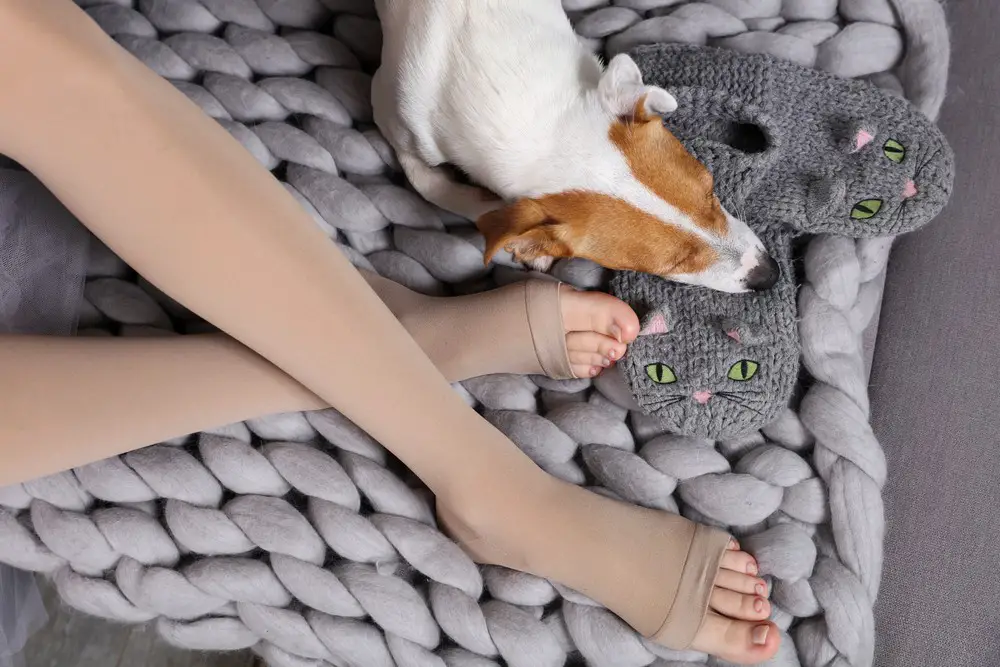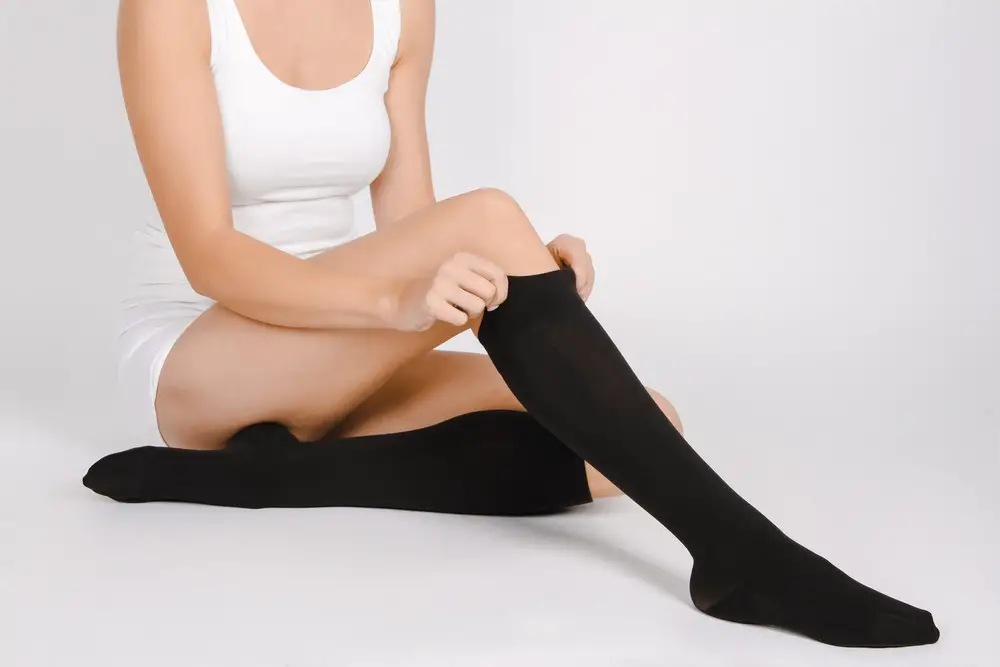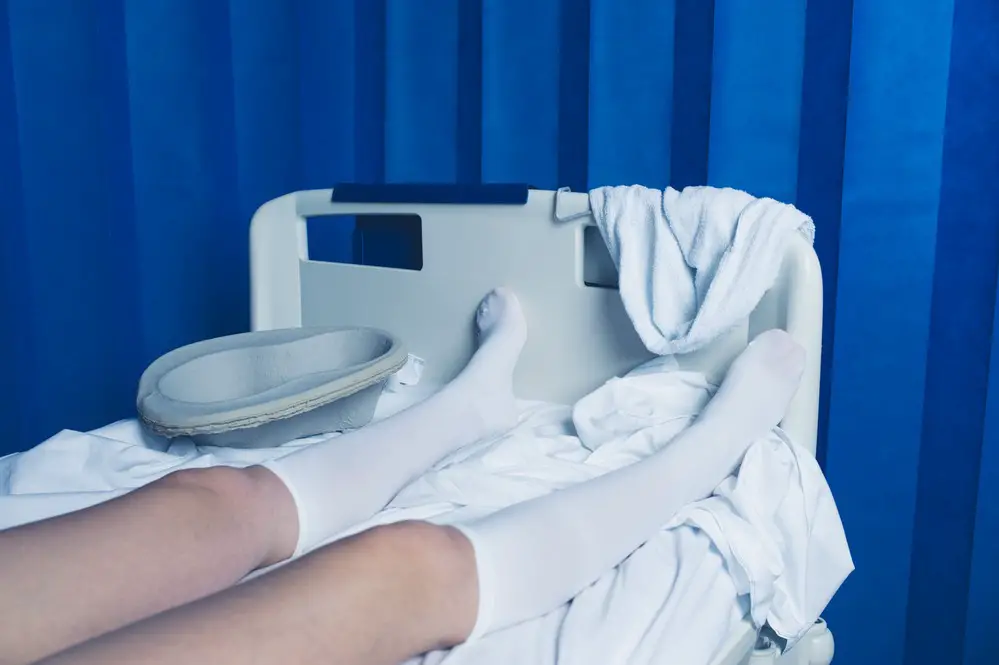As a BetterHelp affiliate, we receive compensation from BetterHelp if you purchase products or services through the links provided
Sleeping with compression socks on is a topic that has been debated over the years. Some people swear by it, reporting better sleep, improved circulation, and reduced leg swelling. Others caution against it, suggesting there may be potential risks or discomforts when wearing compression socks in bed. Regardless of one’s perspective, it’s essential to understand the purpose of compression socks and their potential benefits and drawbacks during sleep.
Compression socks are designed to apply pressure to the legs, improving blood flow and reducing the risk of various circulation-related health issues such as chronic venous insufficiency and deep vein thrombosis. Many individuals wear them during the day while standing or sitting for prolonged periods. However, the question remains: can these same benefits be achieved by wearing compression socks during sleep, or do the potential disadvantages outweigh the positives?
Key Takeaways
- Compression socks may improve sleep and circulation for some individuals
- Potential risks and discomforts should be considered when wearing during sleep
- Consult a healthcare provider for personalized advice on bedtime use

Wearing Compression Socks during Sleep
Benefits of Wearing Compression Socks at Night
Wearing compression socks at night can benefit individuals experiencing various circulatory issues. These socks work by applying gentle pressure to the legs, improving blood flow and keeping veins in good condition.
One primary advantage of sleeping with compression socks is the improvement in circulation. Wearing these socks helps maintain proper blood flow, preventing blood from pooling in the legs due to gravity. This improvement in circulation can reduce the risk of deep vein thrombosis (DVT) and venous insufficiency.
Swelling, or edema, is also a common issue that can be alleviated by wearing compression socks at night. They help minimize leg swelling by promoting better blood flow and reducing fluid buildup in the lower extremities. As a result, people who suffer from swollen feet and legs may find relief by wearing compression socks during sleep.
Another benefit of wearing compression socks at night is the support and reduced muscle fatigue. The gentle pressure these socks provide can support the muscles and promote better oxygenation, thus minimizing muscle fatigue. This can contribute to a quicker recovery for individuals who engage in physical activities.
In summary, wearing compression socks at night can offer several health benefits, including improved circulation, reduced swelling, and muscle fatigue relief. By incorporating them into a nightly routine, individuals can achieve better overall leg health and a more comfortable sleep experience.
Possible Risks and Discomforts
Skin Irritation and Infection
Wearing compression socks for extended periods or while sleeping may lead to skin irritation or infection. The fabric may cause friction against the skin, and in some cases, individuals may react to the materials. It is essential to consult a doctor or health care provider if any signs of skin irritation or infection occur.
Additionally, moisture can get trapped between the sock and the skin, creating an ideal environment for bacteria growth. Therefore, it’s crucial to choose moisture-wicking fabrics for compression socks and to maintain proper hygiene practices.

Tightness and Fitting Issues
Improperly fitted compression socks may cause discomfort and potential health risks. Graduated compression should be adjusted adequately to provide the right level of tightness. Too loose, and the socks may not provide the desired benefits; too tight, and they can restrict blood flow and cause discomfort.
Individuals should consult their healthcare provider for guidance on selecting the appropriate compression level and fitting for their needs. Proper sizing and fit are vital to avoid tightness, discomfort, and potential circulation issues.
Who May Benefit from Sleeping with Compression Socks
Pregnancy and Varicose Veins
During pregnancy, a woman’s circulatory system undergoes significant changes, making it more difficult for blood to flow freely from the legs to the heart. This increase in pressure can lead to the development of varicose veins. Wearing compression socks while sleeping may help alleviate this pressure, promoting better blood flow and reducing the discomfort associated with varicose veins. Pregnant women should consult their healthcare provider before using compression socks to ensure they are appropriate for their needs.
Athletes and Post-Workout Recovery
The benefits of compression socks go beyond regular exercise routines for athletes. Following intense workouts, muscles need time to recover, and proper circulation assists in this process by delivering oxygen and nutrients to the affected muscles. Wearing compression socks during sleep can enhance post-workout recovery, helping athletes maximize performance and reduce the risk of injury.
In addition, compression socks can help reduce the risk of blood clots by promoting circulation in the lower extremities. This is particularly important for athletes who spend most of their day standing or sitting, as these positions can increase the risk of blood clot formation. However, it is essential to consult a healthcare provider before using compression socks to prevent blood clots.
Maintaining a comfortable core body temperature while sleeping is crucial for overall health. Compression socks can contribute to temperature regulation, ensuring the body remains at an optimal temperature throughout the night. This, in turn, allows athletes to achieve more restful sleep, which is vital for effective recovery and performance improvement.
Alternatives to Wearing Compression Socks in Bed
When managing cold feet or hot flashes, several alternatives exist to wearing compression socks in bed. These options can provide similar benefits without the potential discomfort of compression socks.
Cold Feet Management
For those who struggle with cold feet, here are some alternative ways to keep them warm:
- Wear regular socks: Normal, non-compression socks can provide warmth and comfort during sleep without applying pressure to your legs.
- Use slippers: Slippers help to insulate your feet, especially during colder months. Simply put them on and take them off before getting under the covers.
- Hot water bottle: Placing a hot bottle at the foot of your bed can provide gentle warmth throughout the night, ensuring your feet remain cozy and comfortable.
Hot Flashes Management
For individuals who experience hot flashes, consider these methods to help alleviate symptoms during sleep:
- Choose moisture-wicking sleepwear: Breathable, moisture-wicking materials can help regulate your body temperature and keep you comfortable during the night.
- Ensure proper room ventilation: Keeping the room cool and well-ventilated can help minimize hot flashes. Consider using a fan, opening windows, or adjusting the thermostat.
- Use cooling bedding: Opt for bedding and pillows that feature cooling technologies, such as gel-infused memory foam or moisture-wicking materials, to help regulate your body’s temperature throughout the night.
Usage and Fitting Tips
Donning and Doffing Compression Stockings
When wearing compression stockings, properly putting them on and taking them off is essential. Here are a few tips for donning and doffing compression stockings to maximize their benefits and prolong their lifespan:
- Start with clean, dry skin: Before putting on compression stockings, ensure no residual lotion or oil on the skin, as it could make the fabric slip. Dry off any moisture to improve adherence.
- Turn the stocking inside out: Folding the stocking in half by grasping the top and pulling it inside out makes it easier to put on.
- Slide the stocking up gradually: Once the stocking is inside out, position the foot, ensuring the heel is correctly placed. Gently unravel the stocking upwards, avoiding any creases or wrinkles.
- Smooth out wrinkles and adjust: After the stocking is on, use the palms of both hands to smooth out any wrinkles and ensure an even distribution of pressure.
- Check for accurate fit: Confirm that the stocking is not too tight around the toes or cutting off circulation at the top band. The top should sit just below the knee or mid-thigh, depending on the length.
To remove compression stockings, follow these steps:
- Gently roll down: Pinch the top band and slowly roll the stocking down the leg, careful not to pull on the fabric too hard.
- Carefully remove from the foot: Gently slide the stocking off the foot once the stocking is rolled down. Avoid yanking or stretching the material.
Although compression stockings are primarily designed for legs, people may also experience swelling, discomfort, or poor arm circulation. In such cases, they should consider wearing specialized compression sleeves for arms. These tips for donning and doffing can be applied to arm sleeves. Always consult a healthcare professional before wearing compression stockings or sleeves to ensure they are appropriate for the individual’s medical condition.
When to Consult a Healthcare Provider
It is essential to consult a healthcare provider if you consider wearing compression socks while sleeping, especially if you have any underlying health issues. For instance, individuals with orthostatic hypotension may need guidance on whether sleeping with compression socks is safe and beneficial for their condition.
The duration of wearing compression socks also varies depending on individual needs. Sometimes, a healthcare provider recommends wearing them for a certain period, while others suggest a different duration. Manufacturers often provide guidelines on the appropriate usage and duration; however, seeking professional advice to ensure safe and effective usage tailored to your specific needs is still crucial.
Proper hygiene is another factor to remember when wearing compression socks for an extended period. A healthcare provider can offer guidance on maintaining cleanliness and avoiding potential side effects from prolonged use. This may include recommendations on how often to wash the socks and tips for maintaining good skin health.
In conclusion, consulting with a healthcare provider is an important step in determining if wearing compression socks while sleeping is the right choice for you. They can assess your personal needs, consider any existing medical conditions, and provide guidance on the appropriate use, duration, and hygiene necessary to safely and efficiently use compression socks.
Frequently Asked Questions
Is it safe to wear compression socks at night?
It is generally safe to wear compression socks at night. However, individuals should consult with a healthcare professional before doing so, as each person’s needs may vary.
What are the benefits of sleeping in compression socks?
Sleeping in compression socks can provide several benefits, such as reducing leg swelling, improving blood circulation, and alleviating discomfort from various conditions, such as varicose veins and edema.
How long should I wear compression socks?
The length of time to wear compression socks depends on the individual’s needs and the advice of a healthcare professional. Some people may need to wear them for a few hours, while others may need to wear them throughout the day and night.
Can compression socks reduce swelling?
Compression socks can reduce swelling by applying pressure to the legs, which helps promote blood flow and reduce fluid buildup. They can be particularly helpful for individuals sitting or standing for long periods.
Are compression socks safe for pregnant sleepers?
Pregnant individuals can benefit from wearing compression socks, as they may experience leg swelling or discomfort due to increased blood volume and hormonal changes. However, it is essential to consult a healthcare professional before using compression socks during pregnancy.
Can diabetics use compression socks at bedtime?
Diabetic individuals may benefit from wearing compression socks at bedtime, as they can improve blood circulation and reduce the risk of developing diabetic neuropathy. However, consulting a healthcare professional before using compression socks is crucial.
- 7 Ideas to Help You Relax and Unwind on a Family Vacation - April 27, 2025
- How Having Cybersecurity Protection Helps You Relax - April 25, 2025
- 8 Reasons Why Spending Time Outside Calms You Down - April 25, 2025
This site contains affiliate links to products. We will receive a commission for purchases made through these links.



